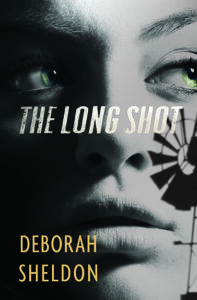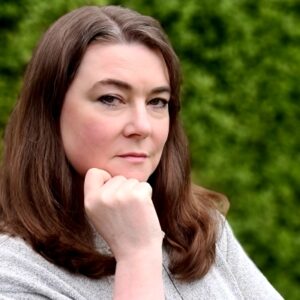 Today’s special guest is suspense writer Deborah Sheldon to chat about her novella, The Long Shot.
Today’s special guest is suspense writer Deborah Sheldon to chat about her novella, The Long Shot.
Bio:
Deborah Sheldon is an award-winning author from Melbourne, Australia. She writes short stories, novellas and novels across the darker spectrum of horror, crime and noir. Her award-nominated titles include the novels Body Farm Z, Contrition and Devil Dragon; the novella Thylacines; and collection Figments and Fragments: Dark Stories. She won the Australian Shadows ‘Best Collected Work’ Award for Perfect Little Stitches and Other Stories, which was also long-listed for a Bram Stoker. As editor of Midnight Echo 14, she won the Australian Shadows ‘Best Edited Work’ Award. Her short fiction has been nominated for various Australian Shadows and Aurealis Awards, and included in ‘best of’ anthologies. Other credits include feature articles, non-fiction books, TV scripts and award-winning medical writing. http://deborahsheldon.wordpress.com
Welcome, Deborah. Please tell us about your current release.
The Long Shot is a crime-suspense novella with dark themes of domestic abuse, violence and family estrangement, counterbalanced by bright spots of love in its various forms including romantic and familial. Other focal points include forgiveness, compassion, second chances and starting over.
The back-cover blurb reads: Simone Parker visits her home town of Brownbeck after six long years away. When she witnesses a brutal bashing, police officer Mitchell Ross needs her testimony. Simone is keen to help, until she discovers her estranged sister, Claire, might be involved.
The Long Shot was first published by Desert Breeze Publishing (US) in September 2017. DBP closed its doors in June 2018. I submitted The Long Shot to award-winning Australian publisher Twelfth Planet Press, and managing director Alisa Krasnostein loved the story. In fact, she told me that it made her cry! (What an absolutely wonderful reaction! Every writer hopes to evoke a response in the reader.)
The manuscript underwent revision and a few scenes were expanded, so it differs slightly from its first release. That said, The Long Shot has always been an Australian story set in a (fictitious) country town in eastern Victoria. I believe that a story’s location should be treated with the same respect as the story’s protagonist because the location is a character. It’s what I enjoy as a reader, so I make location a priority in my writing.
What inspired you to write this book?
I like to challenge myself as a writer. This is why my career has been so varied – from feature articles to TV scriptwriting to medical writing and more – because the anxiety of not knowing if I can become proficient in a new medium feels stimulating. Prior to The Long Shot, I’d been writing downbeat, melancholy crime and noir stories with horror elements. I wanted to see if I could write a long-form project with an upbeat ending.
While I was working on the outline, I went on a ‘location scout’ with my husband to the Yarra Valley. This rural area isn’t too far from our home and is famous for restaurants, wineries and cheeseries. I took notes and my husband took photographs. My fictitious town of Brownbeck was inspired by the various towns and villages in the region. Hills, dales and trees, paddocks with grazing sheep and cattle, the call of parrots, warble of magpies, the fresh smell of eucalyptus and wattle, architecture of old buildings and farms – all of these things informed Brownbeck and helped me bring it to life in The Long Shot.
Excerpt from The Long Shot:
Here are a few paragraphs from the first chapter…
Simone Parker could see the entire cemetery from the gate. Thankfully, she was the only person there. Correction: the only living person. This cemetery held the remains of many generations of families from the township of Brownbeck, including Simone’s. Involuntarily, her hand tightened on the gate.
A new red-brick toilet block sat alongside the cyclone fence. Apart from that, the cemetery looked exactly the same as she remembered. Back in high school, the ‘bone orchard’ had been the favoured hangout after dark, the meeting place for bored teenagers with nothing to do and nowhere to go in a small country town. She could almost hear the laughter and the chatter; see the boys play-fighting and the girls trying to act cool. The police had occasionally chased them out – the swing of torches the signal to run – but everyone had always come back the very next night, especially Simone, who had never wanted to be at home anyway.
She closed the gate behind her and began to walk the path, her shoes crunching lightly on the gravel. Cockatoos screeched overhead. There was no traffic noise. Simone had expected the area to be more built-up by now, but then again, who would ever want to live in Brownbeck? Unless you had an interest in paddocks or cows, the town had nothing to offer.
The autumn sun came out from behind a cloud. Simone took sunglasses from her handbag and kept walking. The graves on either side of the path were weather-beaten, many of them commemorating deaths from the nineteenth century, the headstones mostly granite or marble. Never forgotten proclaimed one neglected plaque. Simone shivered in the cool air. Hugging into her jacket, she walked faster.
At the sight of one of the monument graves, a bronze obelisk topped with a bronze woman, she pulled up, began to smile. Damn. Right there, behind the grave and hidden from sight, she’d had her first kiss – a chaste pressing of lips – with a tousle-haired boy named Mitchell Ross. She hadn’t thought about that in years. Then the breeze gusted, carrying the sweet, familiar smell of hay, and for a disorienting moment it was like she had never left Brownbeck at all, as if the time she’d spent living and working far away in the northern part of the state, in the regional city of Mildura, had never happened.
Twelfth Planet Press has a free two-chapter sampler of The Long Shot for download: https://claims.prolificworks.com/free/4xr11tBP
What exciting story are you working on next?
Currently, I’m promoting recent works including The Long Shot and my award-nominated titles – the zombie novel Body Farm Z (Severed Press) and the collection Figments and Fragments: Dark Stories (IFWG Publishing Australia).
I’ve jotted down the bones of a short story so that will be my next project.
After that, I’ll probably write a few more short stories since I’ve been fortunate enough to secure a contract for another collection, due for release in 2022. I’m very excited about this and already have the title – Liminal Spaces: Horror Stories.
Way back in 2019, I outlined a novel. Although I’m keen to start, I’ll need to wait for a bigger space in my schedule because novels are tremendously demanding and time-consuming. Perhaps I’ll break ground on the project in the first half of 2021.
 When did you first consider yourself a writer?
When did you first consider yourself a writer?
While holding a cheque in my hands rather than a rejection letter. It was 1986, back when freelance articles were submitted to magazines via snail mail. I was 18 years old and in my first year of university doing a BA in writing, literature and philosophy. I’d been posting my non-fiction writing assignments to magazines for a few months but it was an article on steroid abuse, sent to an Australian bodybuilding magazine, that kicked off my professional career.
Do you write full-time? If so, what’s your work day like? If not, what do you do other than write and how do you find time to write?
I’ve been a writer my entire adult life – some 34 years – and have been freelance for most of it. Due to significant health problems, these days I write only part-time and aim for about 20 hours per week.
I divide my work days into ‘fiction writing’ and ‘admin’. On a day when I’m writing creatively, I usually begin by editing my previous pages. Once I’ve warmed up, and again taken hold of my story threads, I write for about four or five hours. Admin days vary according to what’s on my plate; for example, I might answer emails, research an upcoming project, submit stories, do promotion for my published titles, and so on.
After hours, I’m a homebody. I like to cook for my family, read, watch old black-and-white movies, lose myself down Internet rabbit holes, be with loved ones.
Carving out time to write has never been an issue for me. I’m passionately committed to my craft and always make writing a priority.
What would you say is your interesting writing quirk?
I get most of my writing epiphanies in the shower. Whether it’s the germ of a story idea, a mashing together of separate ideas to make a plot, or the answer to a hellishly tricky corner I’ve written myself into, the act of washing my hair somehow opens a door into my creative mind that I can’t access any other way.
And I don’t know why! There’s no deliberate troubleshooting or brainstorming going on – the solution hits me straight out of my subconscious, fully formed, like the proverbial bolt of lightning. Bizarre…but I’m not willing to investigate the phenomenon in case I ruin its delicate, weird, inexplicable magic.
As a child, what did you want to be when you grew up? (N.B. to Lisa – my answer is verbatim from the interview I did with you in 2018. There didn’t seem to be any better way to say it!)
In order: a bus driver, Wonder Woman, an illustrator for superhero comics. But I realised at about the age of 11 that writing was my one true love.
Anything additional you want to share with the readers?
I’ve branched into something new. In 2019, Greg Chapman (who was then president of the Australasian Horror Writers Association) invited me to guest-edit Midnight Echo, the AHWA’s annual magazine. Since I’d been mulling over the idea of moving sideways into anthology editing, I interpreted this unexpected invitation as Fate! Of course, I accepted.
Much to my delight, I ended up winning the ‘Best Edited Work’ Australian Shadows Award for Midnight Echo 14. One of the stories, “The Netherwhere Line” by Matthew J. Morrison, was also shortlisted for an Australian Shadows Award. Very gratifying!
Soon after accepting Greg’s offer, I pitched my own anthology idea to Gerry Huntman, managing director of the award-winning speculative fiction press, IFWG Publishing Australia. Gerry was enthusiastic and offered me a contract immediately. Spawn: Weird Horror Tales About Pregnancy, Birth and Babies was inspired by my thematic preoccupations surrounding my short story, “Hair and Teeth”, first published in Aurealis magazine, selected for Year’s Best Hardcore Horror, and considered recommended reading by Ellen Datlow. Spawn includes commissioned work by multi-award-winning and bestselling authors Jack Dann, Kaaron Warren and Sean Williams, plus work by Australian writers via open callout. Publication will be May 2021. Two sequels are planned – one will be by Australasian writers and the other international writers.
Anthology editing is a satisfying, challenging and demanding endeavour. It’s wonderful to work with so many writers. On the downside, however, having to send out rejection letters keeps me up at nights. I guess I’m a softy.
Links:
Website | Facebook | Goodreads | Amazon Author Page
